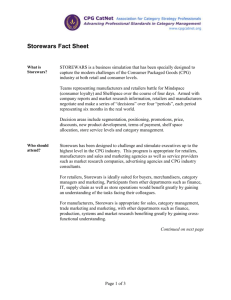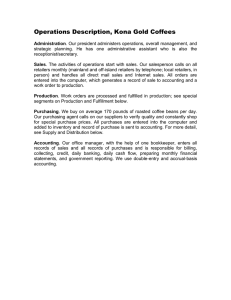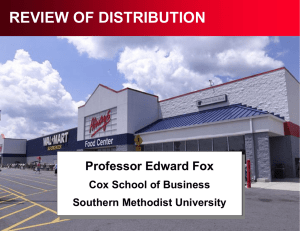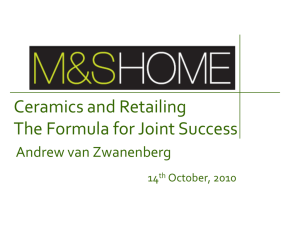Retailers and Store Brand Manufacturers Develop Standards Together
advertisement
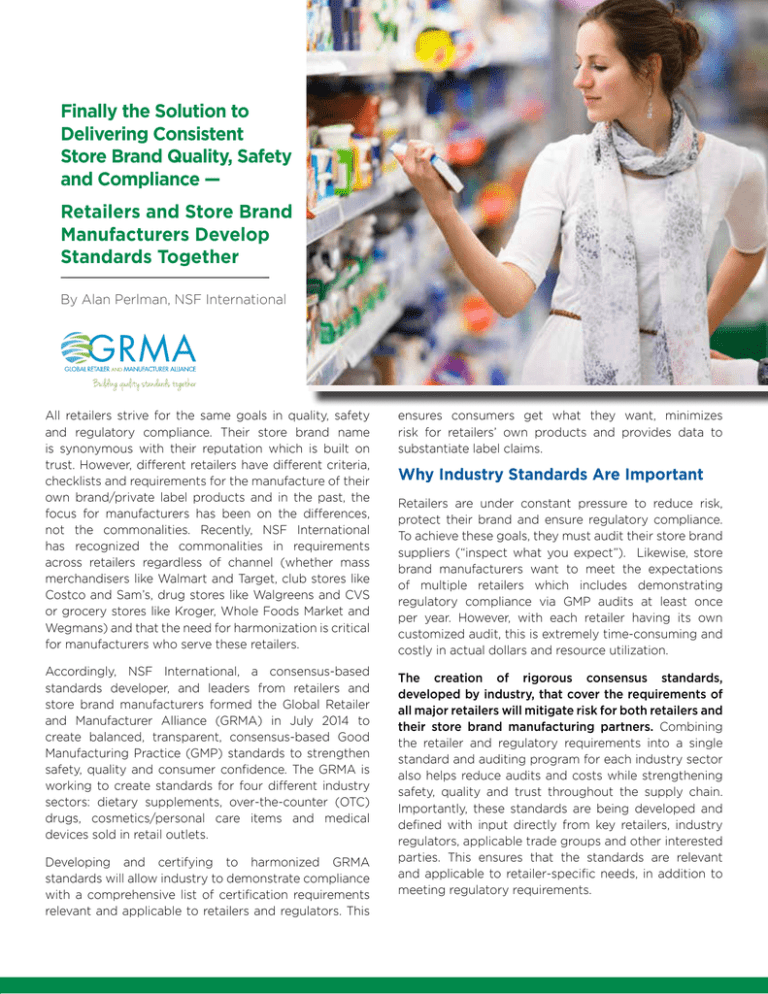
Finally the Solution to Delivering Consistent Store Brand Quality, Safety and Compliance — Retailers and Store Brand Manufacturers Develop Standards Together By Alan Perlman, NSF International All retailers strive for the same goals in quality, safety and regulatory compliance. Their store brand name is synonymous with their reputation which is built on trust. However, different retailers have different criteria, checklists and requirements for the manufacture of their own brand/private label products and in the past, the focus for manufacturers has been on the differences, not the commonalities. Recently, NSF International has recognized the commonalities in requirements across retailers regardless of channel (whether mass merchandisers like Walmart and Target, club stores like Costco and Sam’s, drug stores like Walgreens and CVS or grocery stores like Kroger, Whole Foods Market and Wegmans) and that the need for harmonization is critical for manufacturers who serve these retailers. ensures consumers get what they want, minimizes risk for retailers’ own products and provides data to substantiate label claims. Accordingly, NSF International, a consensus-based standards developer, and leaders from retailers and store brand manufacturers formed the Global Retailer and Manufacturer Alliance (GRMA) in July 2014 to create balanced, transparent, consensus-based Good Manufacturing Practice (GMP) standards to strengthen safety, quality and consumer confidence. The GRMA is working to create standards for four different industry sectors: dietary supplements, over-the-counter (OTC) drugs, cosmetics/personal care items and medical devices sold in retail outlets. The creation of rigorous consensus standards, developed by industry, that cover the requirements of all major retailers will mitigate risk for both retailers and their store brand manufacturing partners. Combining the retailer and regulatory requirements into a single standard and auditing program for each industry sector also helps reduce audits and costs while strengthening safety, quality and trust throughout the supply chain. Importantly, these standards are being developed and defined with input directly from key retailers, industry regulators, applicable trade groups and other interested parties. This ensures that the standards are relevant and applicable to retailer-specific needs, in addition to meeting regulatory requirements. Developing and certifying to harmonized GRMA standards will allow industry to demonstrate compliance with a comprehensive list of certification requirements relevant and applicable to retailers and regulators. This Why Industry Standards Are Important Retailers are under constant pressure to reduce risk, protect their brand and ensure regulatory compliance. To achieve these goals, they must audit their store brand suppliers (“inspect what you expect”). Likewise, store brand manufacturers want to meet the expectations of multiple retailers which includes demonstrating regulatory compliance via GMP audits at least once per year. However, with each retailer having its own customized audit, this is extremely time-consuming and costly in actual dollars and resource utilization. How the GRMA Is Creating Harmonized Standards In 2014, the “DNA” of what would become the GRMA met to discuss the aspirational goals. Led by quality and safety experts from leading supermarkets, drugstore chains, mass merchandisers, club stores and manufacturers (including Walgreens, Walmart, Wegmans, Costco, Perrigo and First Quality), the representatives developed a blueprint to create standardized requirements for each product category. The team also utilized insights from industry experts such as the American National Standards Institute (ANSI), Council for Responsible Nutrition (CRN), Nutrition Business Journal (NBJ) and NSF International. Retailers generally have similar overall requirements but the auditing and testing components may differ slightly. Manufacturers welcome uniform standards because they provide a clear, consistent “roadmap” for meeting multiple retailer requirements with, at minimum, one annual audit as part of the certification process. Standardization of requirements across retailers is not a “one size fits all” process where only shared criteria are incorporated. Instead, the standards will encompass retailer requirements, shared and unique, above and beyond regulatory requirements for GMPs. A single standard ensures retailers that all their unique, specific requirements are being met. When one retailer has a requirement the others don’t, incorporating it benefits all retailers - not just the one - by strengthening criteria across the board. Manufacturers also benefit because they can meet ALL retailer criteria with one certification. The GRMA Standards The GRMA is developing four standards that will initially define a consistent approach for auditing, and later for product testing and claim substantiation. The standards encompass both relevant regulations and additional uniform retailer requirements. The applicable regulations serve as a baseline for each standard including: • Dietary supplements – Current Good Manufacturing Practices (GMPs) in Manufacturing, Packaging, Labeling, Holding Operations for Dietary Supplements (Title 21 of the Code of Federal Regulations (CFR) Parts 110 and 111 which are a component and requirement of the only American National Standard for dietary supplements, NSF/ANSI 173. • Cosmetics/personal care products – ISO 22716 and U.S. FDA Cosmetic GMP Guidance encompassing GMPs for the production, control, storage and shipment of cosmetic products. • OTC drug products – GMPs in manufacturing, processing, packing or holding of drugs for finished pharmaceuticals (21 CFR Parts 210 and 211). May include parts of the only standard for GMPs in pharmaceutical excipients, NSF/IPEC/ANSI 363. • Medical devices – Quality system regulation/GMPs for medical devices (21 CFR Part 820) and medical device reporting (21 CFR Part 803). Certification Criteria The GRMA initiative builds on existing regulatory requirements and also meets and standardizes retailer requirements. Certification criteria vary based on the specific product and include: • Audits – Audits are required for initial certification and annually or biannually thereafter. Audits verify Good Manufacturing Practices, which includes laboratory testing requirements, production and process controls, personnel qualifications, cleaning procedures, equipment maintenance and more. • Product testing – May include ingredient, finished product and contaminant testing, including physical (properties, performance and integrity), microbiological and analytical testing. • Label claim verification — May consist of toxicology, formulation and/or label reviews of ingredients and marketing claims such as organic, gluten-free, non-GMO, allergen-free, EPA Safer Choice, landfill-free, fragrance-free, compostable, non-toxic and sustainability. Bottom line, substantiation of all label claims is required to meet the expectations of the retailers. Standard Development Process The GRMA program was the culmination of initial input on concept feasibility and subsequent buy-in from retailers, who then identified their key vendor partners in store brand manufacturing. NSF International is leading the ANSI standard development process, which includes submitting formal standard notifications to ANSI’s Project Initiation Notification System (PINS). The ANSI consensus process also includes ensuring balanced input from a variety of stakeholders by forming a joint committee (JC) for each standard, comprised of users (manufacturers and certifiers), industry (retailers) and public health stakeholders such as regulatory agencies, academia and other interested parties. The JC is a standing group that is the consensus body responsible for the standard. JC members vote on recommendations, provide technical guidance and can serve on task groups. Membership is based on an applicant’s experience and expertise in the industry. There can only be one member per company and the total number of representatives from each of the three stakeholder groups must be equal with a minimum of five representatives from each group. In addition to the joint committee, task groups led by those store brand manufacturers and retailers may also be formed to investigate particular issues of standards development. Retailers are represented in all four industry categories, some serving on multiple groups. The task groups are responsible for specific topics within a standard. Members solve specific issues and create recommendations for the JC to vote on. Membership may be standing or ad hoc, with members coming from the JC or other sources. Status of GRMA Standards Development Standard development is underway for each of the four industries - dietary supplements, cosmetics/personal care products, OTC drugs and medical devices. Work on the dietary supplements standard began first, by submitting PINS notification and utilizing the current industry-accepted NSF dietary supplement certification program as a template. The joint committee will be using the only American National Standard for dietary supplements, NSF/ANSI 173, as a template for the new standard, and defining and incorporating the remaining retailer needs and requirements into the GRMA standard. Additionally, the task groups are also working to detail key elements of the Code of Federal Regulations (CFR) Title 21, Part 110 and Part 111, which cover GMPs for manufacturing, packaging, labeling or holding food or dietary supplements, respectively. The Federal Food, Drug, and Cosmetic (FD&C) Act states that these products must not be adulterated or mislabeled, but it does not specify methods or validations for achieving these guidelines. The GRMA standards will incorporate these specifications to make it easier for companies to have processes in place to demonstrate compliance. Uniform Standards Benefit Manufacturers, Retailers and Consumers Certification to GRMA standards provides much more than a third-party certification logo (product mark) for consumer confidence. The documentation resulting from independent, third-party certification – comprehensive audit reports, test results and label claim verification – provides manufacturers with both the dossier they need to approach a retailer and peace of mind for regulatory compliance, product quality and consumer safety. This data also provides a means for retailers to verify label claims and protect their brands by reducing risk. Retailers are responsible for assuring all private label products are made as per applicable regulations, and the retailer, whose name is on the product, bears the risk for any non-conformances. For example, the recent NY Attorney General actions against several store brand herbal supplements may have damaged consumer confidence in all store brand supplements, and this could have been avoided, or quickly mitigated, if the appropriate documentation confirming all product claims had been on file. Retailer brands certified to a GRMA standard will meet the highest level of quality, safety and regulatory compliance, with added claims substantiation, and the third-party certification logo for the product adds assurance for the customer that the product meets all of the applicable standard’s requirements. Adherence to these new standards can lower the chance of a product recall as the steps involved in achieving certification require documented processes and procedures that increase safety and quality and minimize risks. While these standards are being developed for the own brand/private label industry, the business, regulatory and brand protection benefits may cause national brands to follow suit in seeking certification. Next Steps for GRMA Standards The GRMA met in August 2015 to review and assess progress in each category. The joint committees are being seated and chairs are being established, driving toward the final goal of creating standards. The GRMA is open to all retailers, store brand manufacturers, relevant trade associations, regulatory and public health institutions, and certification bodies with a formal application approval. For more information or if you would like to participate in the development of the standards, please contact Casey Coy , GRMA Program Manager, at GRMA@nsf.org. About the Author Alan Perlman is Business Development Director - Consumer Products and Retailer Services for NSF International. He has more than 35 years’ experience in store brand product quality, testing and technical evaluation. Perlman’s unique perspective includes insight into product evaluations from the viewpoint of both the lab and the store brand manufacturer. Before joining NSF, Perlman served for 16 years as Technical Director for Rockline Industries and for 13 years as an Account Executive and Vice President at Herbert V. Shuster, Inc. For more information, contact GRMA@nsf.org or +1 866.520.5224. World Headquarters NSF International 789 N. Dixboro Rd., Ann Arbor, MI 48105 p +1 866.520.5224 f +1 734.769.0109 Email: GRMA@nsf.org • Web: www.nsf.org LHP-2917-1015

